Strategic Financial Management: Investment, Risk & Dividend Decisions
VerifiedAdded on 2023/04/22
|19
|4031
|356
Report
AI Summary
This report provides a comprehensive analysis of strategic financial management concepts, focusing on investment appraisal, risk management, and dividend policy. It begins with a Net Present Value (NPV) analysis of an investment proposal, considering initial investment, annual cash flows, and the impact of inflation. The report then discusses the impact of inflation on capital analysis, exploring real and nominal terms. Furthermore, it examines risk in capital analysis, detailing different approaches such as sensitivity and scenario analysis. The concept of real options is also explored, highlighting its flexibility and benefits in making strategic decisions. Finally, the report delves into optimal dividend policy, discussing various theoretical arguments including Walter’s Model, Modigliani-Miller Model, and the Bird in Hand Argument. This student-contributed assignment is available on Desklib, where students can find a wealth of resources including past papers and solved assignments.

Name of schedule:
Student reference number:
Title of assignment: Strategic Financial Management
Actual number of words: 2718
Student reference number:
Title of assignment: Strategic Financial Management
Actual number of words: 2718
Paraphrase This Document
Need a fresh take? Get an instant paraphrase of this document with our AI Paraphraser
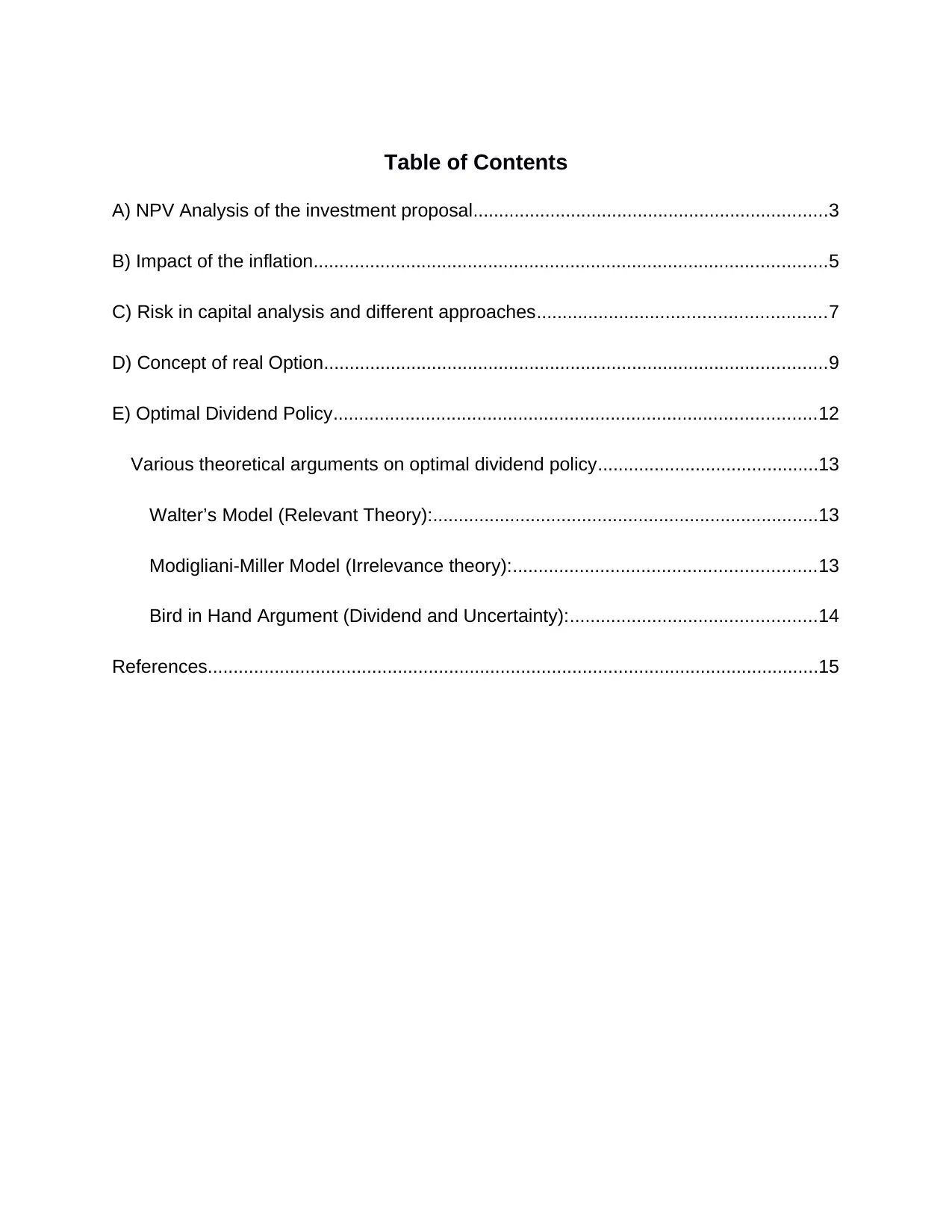
Table of Contents
A) NPV Analysis of the investment proposal.....................................................................3
B) Impact of the inflation....................................................................................................5
C) Risk in capital analysis and different approaches........................................................7
D) Concept of real Option..................................................................................................9
E) Optimal Dividend Policy..............................................................................................12
Various theoretical arguments on optimal dividend policy...........................................13
Walter’s Model (Relevant Theory):...........................................................................13
Modigliani-Miller Model (Irrelevance theory):...........................................................13
Bird in Hand Argument (Dividend and Uncertainty):................................................14
References.......................................................................................................................15
A) NPV Analysis of the investment proposal.....................................................................3
B) Impact of the inflation....................................................................................................5
C) Risk in capital analysis and different approaches........................................................7
D) Concept of real Option..................................................................................................9
E) Optimal Dividend Policy..............................................................................................12
Various theoretical arguments on optimal dividend policy...........................................13
Walter’s Model (Relevant Theory):...........................................................................13
Modigliani-Miller Model (Irrelevance theory):...........................................................13
Bird in Hand Argument (Dividend and Uncertainty):................................................14
References.......................................................................................................................15
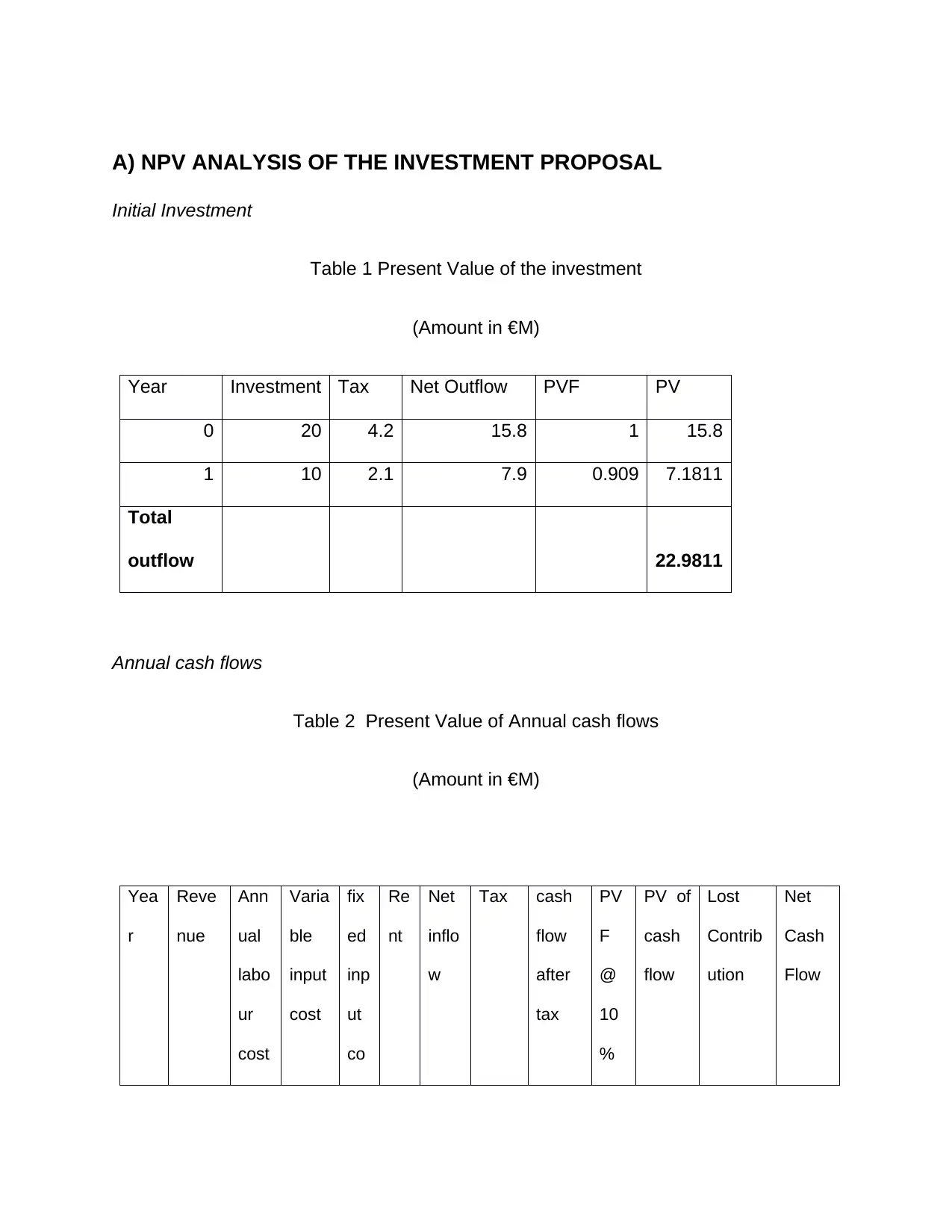
A) NPV ANALYSIS OF THE INVESTMENT PROPOSAL
Initial Investment
Table 1 Present Value of the investment
(Amount in €M)
Year Investment Tax Net Outflow PVF PV
0 20 4.2 15.8 1 15.8
1 10 2.1 7.9 0.909 7.1811
Total
outflow 22.9811
Annual cash flows
Table 2 Present Value of Annual cash flows
(Amount in €M)
Yea
r
Reve
nue
Ann
ual
labo
ur
cost
Varia
ble
input
cost
fix
ed
inp
ut
co
Re
nt
Net
inflo
w
Tax cash
flow
after
tax
PV
F
@
10
%
PV of
cash
flow
Lost
Contrib
ution
Net
Cash
Flow
Initial Investment
Table 1 Present Value of the investment
(Amount in €M)
Year Investment Tax Net Outflow PVF PV
0 20 4.2 15.8 1 15.8
1 10 2.1 7.9 0.909 7.1811
Total
outflow 22.9811
Annual cash flows
Table 2 Present Value of Annual cash flows
(Amount in €M)
Yea
r
Reve
nue
Ann
ual
labo
ur
cost
Varia
ble
input
cost
fix
ed
inp
ut
co
Re
nt
Net
inflo
w
Tax cash
flow
after
tax
PV
F
@
10
%
PV of
cash
flow
Lost
Contrib
ution
Net
Cash
Flow
⊘ This is a preview!⊘
Do you want full access?
Subscribe today to unlock all pages.

Trusted by 1+ million students worldwide
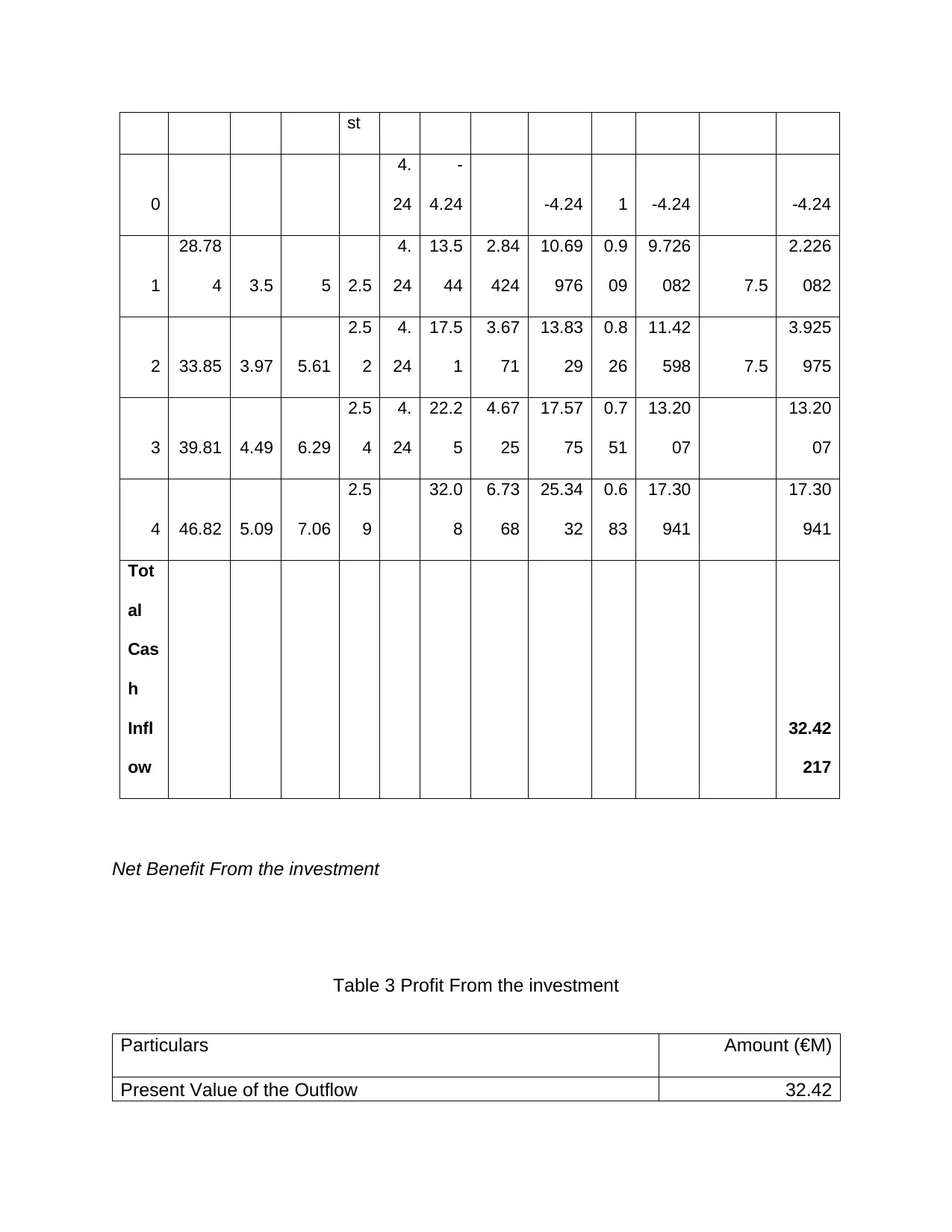
st
0
4.
24
-
4.24 -4.24 1 -4.24 -4.24
1
28.78
4 3.5 5 2.5
4.
24
13.5
44
2.84
424
10.69
976
0.9
09
9.726
082 7.5
2.226
082
2 33.85 3.97 5.61
2.5
2
4.
24
17.5
1
3.67
71
13.83
29
0.8
26
11.42
598 7.5
3.925
975
3 39.81 4.49 6.29
2.5
4
4.
24
22.2
5
4.67
25
17.57
75
0.7
51
13.20
07
13.20
07
4 46.82 5.09 7.06
2.5
9
32.0
8
6.73
68
25.34
32
0.6
83
17.30
941
17.30
941
Tot
al
Cas
h
Infl
ow
32.42
217
Net Benefit From the investment
Table 3 Profit From the investment
Particulars Amount (€M)
Present Value of the Outflow 32.42
0
4.
24
-
4.24 -4.24 1 -4.24 -4.24
1
28.78
4 3.5 5 2.5
4.
24
13.5
44
2.84
424
10.69
976
0.9
09
9.726
082 7.5
2.226
082
2 33.85 3.97 5.61
2.5
2
4.
24
17.5
1
3.67
71
13.83
29
0.8
26
11.42
598 7.5
3.925
975
3 39.81 4.49 6.29
2.5
4
4.
24
22.2
5
4.67
25
17.57
75
0.7
51
13.20
07
13.20
07
4 46.82 5.09 7.06
2.5
9
32.0
8
6.73
68
25.34
32
0.6
83
17.30
941
17.30
941
Tot
al
Cas
h
Infl
ow
32.42
217
Net Benefit From the investment
Table 3 Profit From the investment
Particulars Amount (€M)
Present Value of the Outflow 32.42
Paraphrase This Document
Need a fresh take? Get an instant paraphrase of this document with our AI Paraphraser
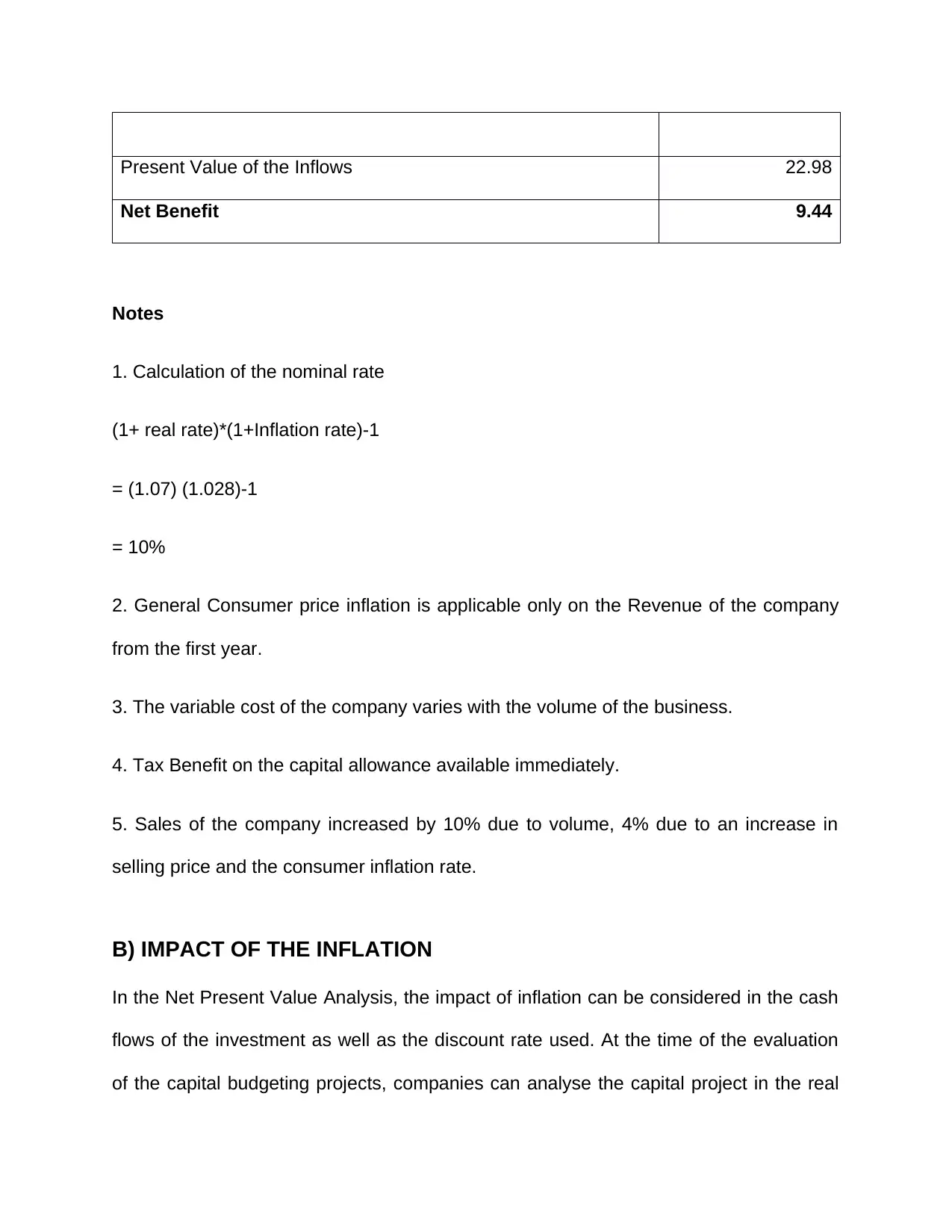
Present Value of the Inflows 22.98
Net Benefit 9.44
Notes
1. Calculation of the nominal rate
(1+ real rate)*(1+Inflation rate)-1
= (1.07) (1.028)-1
= 10%
2. General Consumer price inflation is applicable only on the Revenue of the company
from the first year.
3. The variable cost of the company varies with the volume of the business.
4. Tax Benefit on the capital allowance available immediately.
5. Sales of the company increased by 10% due to volume, 4% due to an increase in
selling price and the consumer inflation rate.
B) IMPACT OF THE INFLATION
In the Net Present Value Analysis, the impact of inflation can be considered in the cash
flows of the investment as well as the discount rate used. At the time of the evaluation
of the capital budgeting projects, companies can analyse the capital project in the real
Net Benefit 9.44
Notes
1. Calculation of the nominal rate
(1+ real rate)*(1+Inflation rate)-1
= (1.07) (1.028)-1
= 10%
2. General Consumer price inflation is applicable only on the Revenue of the company
from the first year.
3. The variable cost of the company varies with the volume of the business.
4. Tax Benefit on the capital allowance available immediately.
5. Sales of the company increased by 10% due to volume, 4% due to an increase in
selling price and the consumer inflation rate.
B) IMPACT OF THE INFLATION
In the Net Present Value Analysis, the impact of inflation can be considered in the cash
flows of the investment as well as the discount rate used. At the time of the evaluation
of the capital budgeting projects, companies can analyse the capital project in the real
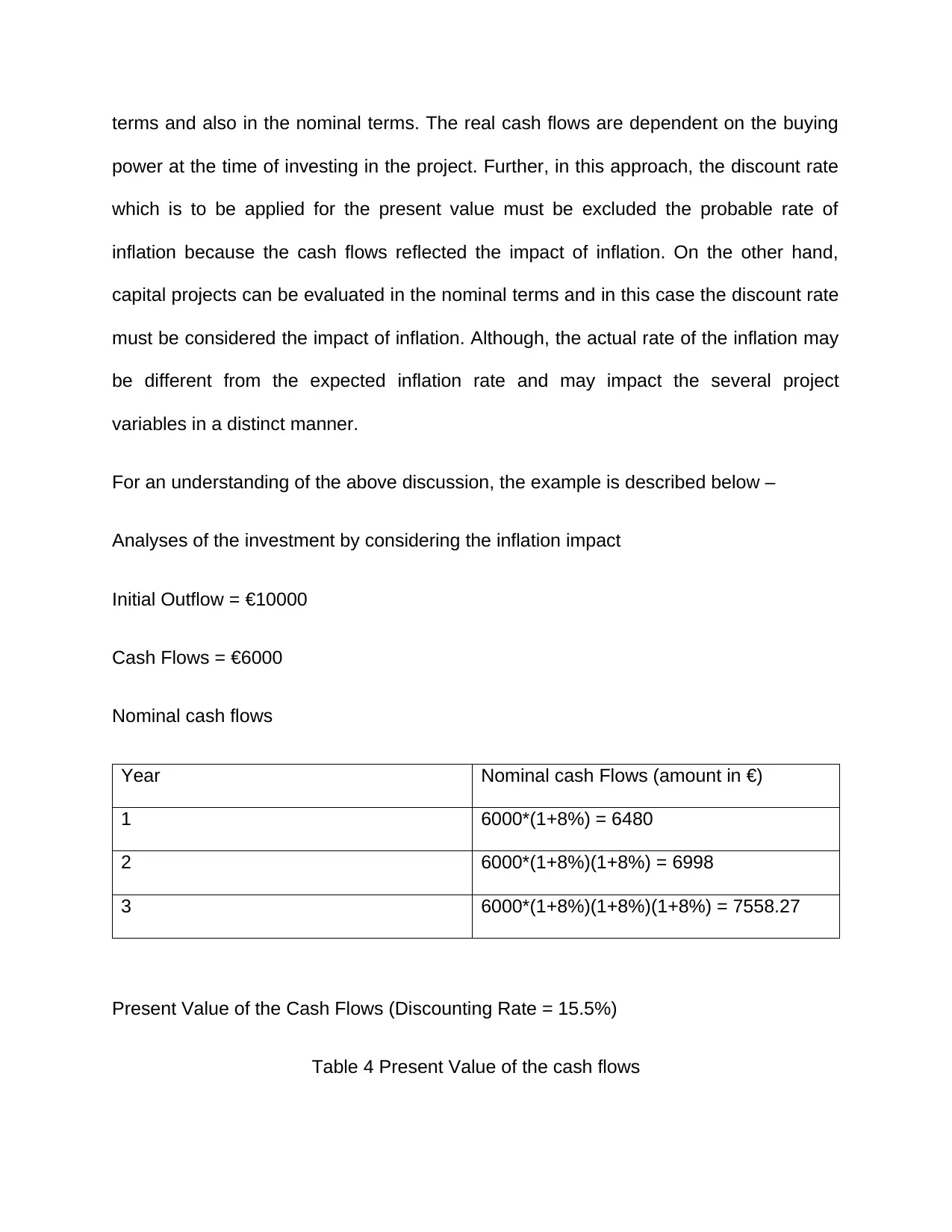
terms and also in the nominal terms. The real cash flows are dependent on the buying
power at the time of investing in the project. Further, in this approach, the discount rate
which is to be applied for the present value must be excluded the probable rate of
inflation because the cash flows reflected the impact of inflation. On the other hand,
capital projects can be evaluated in the nominal terms and in this case the discount rate
must be considered the impact of inflation. Although, the actual rate of the inflation may
be different from the expected inflation rate and may impact the several project
variables in a distinct manner.
For an understanding of the above discussion, the example is described below –
Analyses of the investment by considering the inflation impact
Initial Outflow = €10000
Cash Flows = €6000
Nominal cash flows
Year Nominal cash Flows (amount in €)
1 6000*(1+8%) = 6480
2 6000*(1+8%)(1+8%) = 6998
3 6000*(1+8%)(1+8%)(1+8%) = 7558.27
Present Value of the Cash Flows (Discounting Rate = 15.5%)
Table 4 Present Value of the cash flows
power at the time of investing in the project. Further, in this approach, the discount rate
which is to be applied for the present value must be excluded the probable rate of
inflation because the cash flows reflected the impact of inflation. On the other hand,
capital projects can be evaluated in the nominal terms and in this case the discount rate
must be considered the impact of inflation. Although, the actual rate of the inflation may
be different from the expected inflation rate and may impact the several project
variables in a distinct manner.
For an understanding of the above discussion, the example is described below –
Analyses of the investment by considering the inflation impact
Initial Outflow = €10000
Cash Flows = €6000
Nominal cash flows
Year Nominal cash Flows (amount in €)
1 6000*(1+8%) = 6480
2 6000*(1+8%)(1+8%) = 6998
3 6000*(1+8%)(1+8%)(1+8%) = 7558.27
Present Value of the Cash Flows (Discounting Rate = 15.5%)
Table 4 Present Value of the cash flows
⊘ This is a preview!⊘
Do you want full access?
Subscribe today to unlock all pages.

Trusted by 1+ million students worldwide

Year
Nominal Cash
Flows
Discounting Factor of
15.5% Present value
1 6480 0.866 5611.68
2 6998 0.745 5213.51
3 7558.27 0.649 4905.317
Total 15730.51
Benefit from the investment
Particulars Amount (in €)
Present Value of Inflows 15730.51
Present Value of Outflows 10000
Net Benefit from the investment 5730.51
Analyses of the investment by removing the inflation impact
Initial Outflow = €10000
Cash Flows = €6000
Calculation of the Real Discounting Rate
(Money Rate – Inflation rate) / (1+ inflation rate)
(15.5%-5%)/ (1+5%)
= 10%
Nominal Cash
Flows
Discounting Factor of
15.5% Present value
1 6480 0.866 5611.68
2 6998 0.745 5213.51
3 7558.27 0.649 4905.317
Total 15730.51
Benefit from the investment
Particulars Amount (in €)
Present Value of Inflows 15730.51
Present Value of Outflows 10000
Net Benefit from the investment 5730.51
Analyses of the investment by removing the inflation impact
Initial Outflow = €10000
Cash Flows = €6000
Calculation of the Real Discounting Rate
(Money Rate – Inflation rate) / (1+ inflation rate)
(15.5%-5%)/ (1+5%)
= 10%
Paraphrase This Document
Need a fresh take? Get an instant paraphrase of this document with our AI Paraphraser
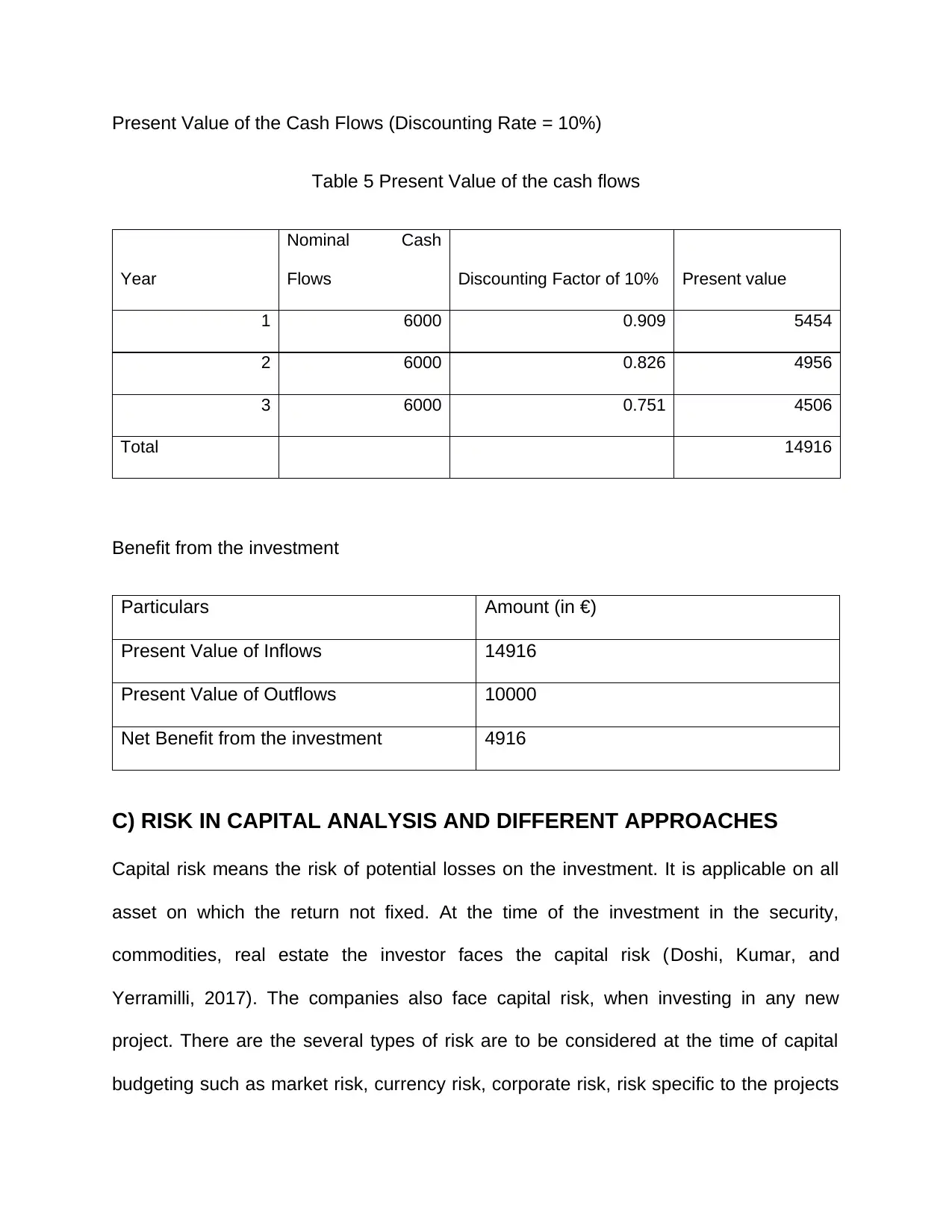
Present Value of the Cash Flows (Discounting Rate = 10%)
Table 5 Present Value of the cash flows
Year
Nominal Cash
Flows Discounting Factor of 10% Present value
1 6000 0.909 5454
2 6000 0.826 4956
3 6000 0.751 4506
Total 14916
Benefit from the investment
Particulars Amount (in €)
Present Value of Inflows 14916
Present Value of Outflows 10000
Net Benefit from the investment 4916
C) RISK IN CAPITAL ANALYSIS AND DIFFERENT APPROACHES
Capital risk means the risk of potential losses on the investment. It is applicable on all
asset on which the return not fixed. At the time of the investment in the security,
commodities, real estate the investor faces the capital risk (Doshi, Kumar, and
Yerramilli, 2017). The companies also face capital risk, when investing in any new
project. There are the several types of risk are to be considered at the time of capital
budgeting such as market risk, currency risk, corporate risk, risk specific to the projects
Table 5 Present Value of the cash flows
Year
Nominal Cash
Flows Discounting Factor of 10% Present value
1 6000 0.909 5454
2 6000 0.826 4956
3 6000 0.751 4506
Total 14916
Benefit from the investment
Particulars Amount (in €)
Present Value of Inflows 14916
Present Value of Outflows 10000
Net Benefit from the investment 4916
C) RISK IN CAPITAL ANALYSIS AND DIFFERENT APPROACHES
Capital risk means the risk of potential losses on the investment. It is applicable on all
asset on which the return not fixed. At the time of the investment in the security,
commodities, real estate the investor faces the capital risk (Doshi, Kumar, and
Yerramilli, 2017). The companies also face capital risk, when investing in any new
project. There are the several types of risk are to be considered at the time of capital
budgeting such as market risk, currency risk, corporate risk, risk specific to the projects
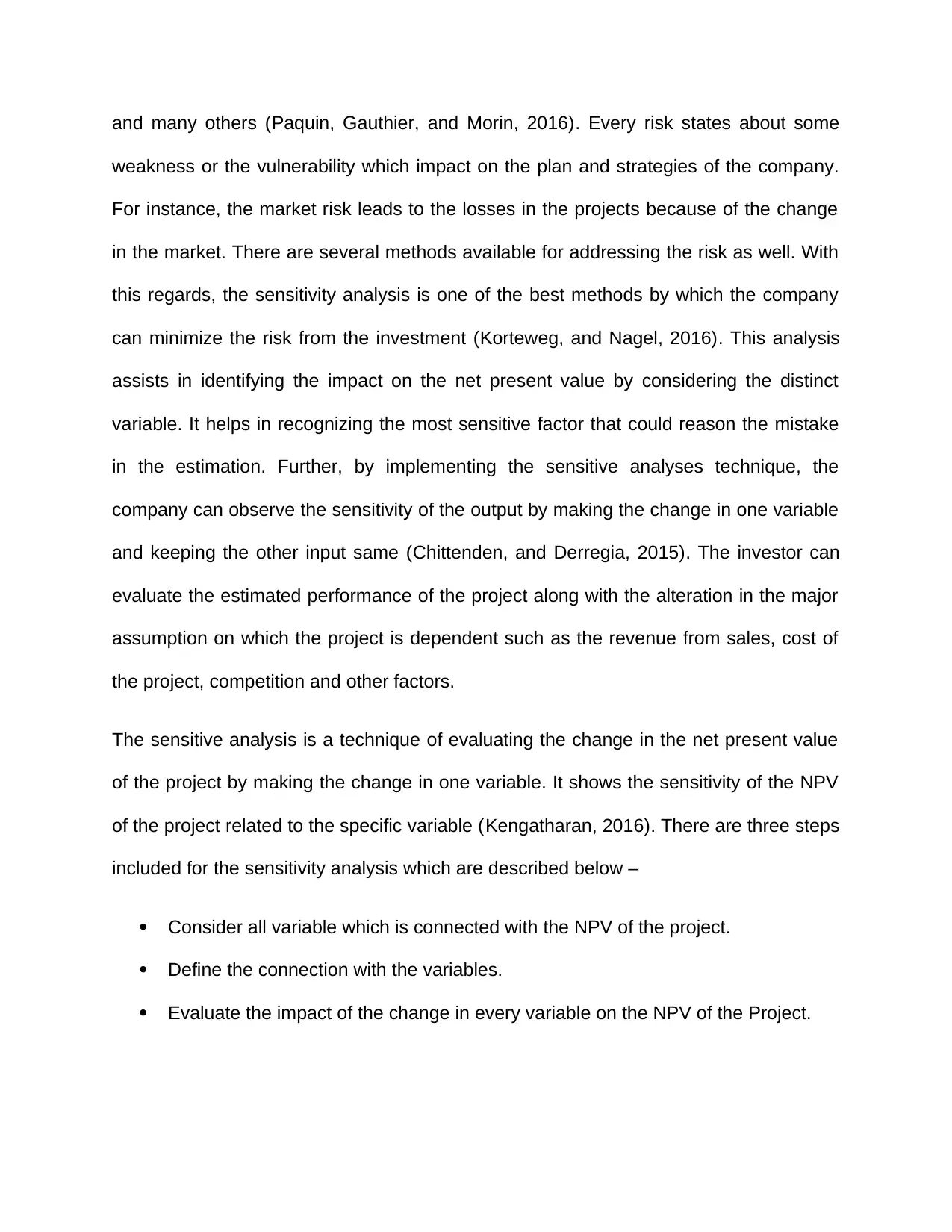
and many others (Paquin, Gauthier, and Morin, 2016). Every risk states about some
weakness or the vulnerability which impact on the plan and strategies of the company.
For instance, the market risk leads to the losses in the projects because of the change
in the market. There are several methods available for addressing the risk as well. With
this regards, the sensitivity analysis is one of the best methods by which the company
can minimize the risk from the investment (Korteweg, and Nagel, 2016). This analysis
assists in identifying the impact on the net present value by considering the distinct
variable. It helps in recognizing the most sensitive factor that could reason the mistake
in the estimation. Further, by implementing the sensitive analyses technique, the
company can observe the sensitivity of the output by making the change in one variable
and keeping the other input same (Chittenden, and Derregia, 2015). The investor can
evaluate the estimated performance of the project along with the alteration in the major
assumption on which the project is dependent such as the revenue from sales, cost of
the project, competition and other factors.
The sensitive analysis is a technique of evaluating the change in the net present value
of the project by making the change in one variable. It shows the sensitivity of the NPV
of the project related to the specific variable (Kengatharan, 2016). There are three steps
included for the sensitivity analysis which are described below –
Consider all variable which is connected with the NPV of the project.
Define the connection with the variables.
Evaluate the impact of the change in every variable on the NPV of the Project.
weakness or the vulnerability which impact on the plan and strategies of the company.
For instance, the market risk leads to the losses in the projects because of the change
in the market. There are several methods available for addressing the risk as well. With
this regards, the sensitivity analysis is one of the best methods by which the company
can minimize the risk from the investment (Korteweg, and Nagel, 2016). This analysis
assists in identifying the impact on the net present value by considering the distinct
variable. It helps in recognizing the most sensitive factor that could reason the mistake
in the estimation. Further, by implementing the sensitive analyses technique, the
company can observe the sensitivity of the output by making the change in one variable
and keeping the other input same (Chittenden, and Derregia, 2015). The investor can
evaluate the estimated performance of the project along with the alteration in the major
assumption on which the project is dependent such as the revenue from sales, cost of
the project, competition and other factors.
The sensitive analysis is a technique of evaluating the change in the net present value
of the project by making the change in one variable. It shows the sensitivity of the NPV
of the project related to the specific variable (Kengatharan, 2016). There are three steps
included for the sensitivity analysis which are described below –
Consider all variable which is connected with the NPV of the project.
Define the connection with the variables.
Evaluate the impact of the change in every variable on the NPV of the Project.
⊘ This is a preview!⊘
Do you want full access?
Subscribe today to unlock all pages.

Trusted by 1+ million students worldwide
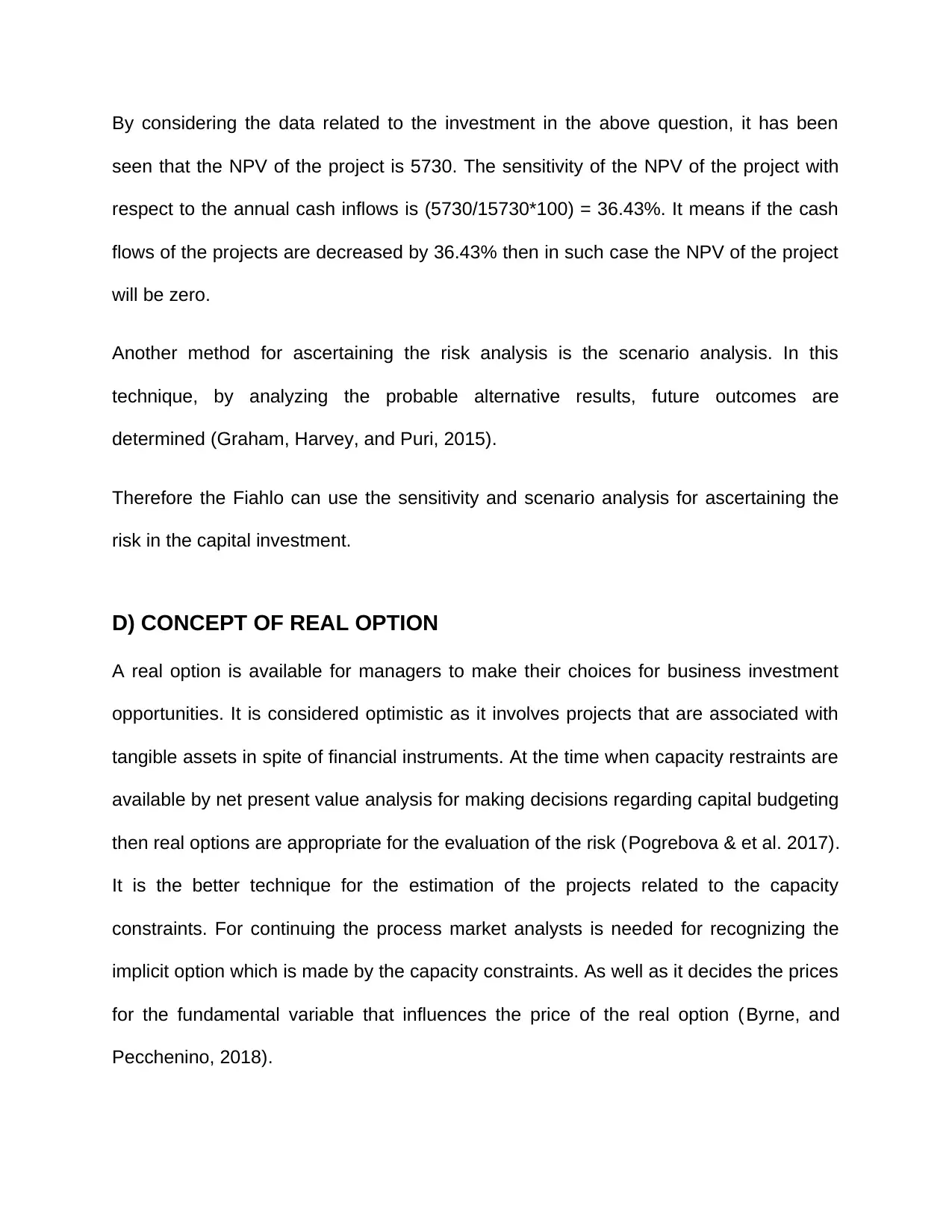
By considering the data related to the investment in the above question, it has been
seen that the NPV of the project is 5730. The sensitivity of the NPV of the project with
respect to the annual cash inflows is (5730/15730*100) = 36.43%. It means if the cash
flows of the projects are decreased by 36.43% then in such case the NPV of the project
will be zero.
Another method for ascertaining the risk analysis is the scenario analysis. In this
technique, by analyzing the probable alternative results, future outcomes are
determined (Graham, Harvey, and Puri, 2015).
Therefore the Fiahlo can use the sensitivity and scenario analysis for ascertaining the
risk in the capital investment.
D) CONCEPT OF REAL OPTION
A real option is available for managers to make their choices for business investment
opportunities. It is considered optimistic as it involves projects that are associated with
tangible assets in spite of financial instruments. At the time when capacity restraints are
available by net present value analysis for making decisions regarding capital budgeting
then real options are appropriate for the evaluation of the risk (Pogrebova & et al. 2017).
It is the better technique for the estimation of the projects related to the capacity
constraints. For continuing the process market analysts is needed for recognizing the
implicit option which is made by the capacity constraints. As well as it decides the prices
for the fundamental variable that influences the price of the real option ( Byrne, and
Pecchenino, 2018).
seen that the NPV of the project is 5730. The sensitivity of the NPV of the project with
respect to the annual cash inflows is (5730/15730*100) = 36.43%. It means if the cash
flows of the projects are decreased by 36.43% then in such case the NPV of the project
will be zero.
Another method for ascertaining the risk analysis is the scenario analysis. In this
technique, by analyzing the probable alternative results, future outcomes are
determined (Graham, Harvey, and Puri, 2015).
Therefore the Fiahlo can use the sensitivity and scenario analysis for ascertaining the
risk in the capital investment.
D) CONCEPT OF REAL OPTION
A real option is available for managers to make their choices for business investment
opportunities. It is considered optimistic as it involves projects that are associated with
tangible assets in spite of financial instruments. At the time when capacity restraints are
available by net present value analysis for making decisions regarding capital budgeting
then real options are appropriate for the evaluation of the risk (Pogrebova & et al. 2017).
It is the better technique for the estimation of the projects related to the capacity
constraints. For continuing the process market analysts is needed for recognizing the
implicit option which is made by the capacity constraints. As well as it decides the prices
for the fundamental variable that influences the price of the real option ( Byrne, and
Pecchenino, 2018).
Paraphrase This Document
Need a fresh take? Get an instant paraphrase of this document with our AI Paraphraser
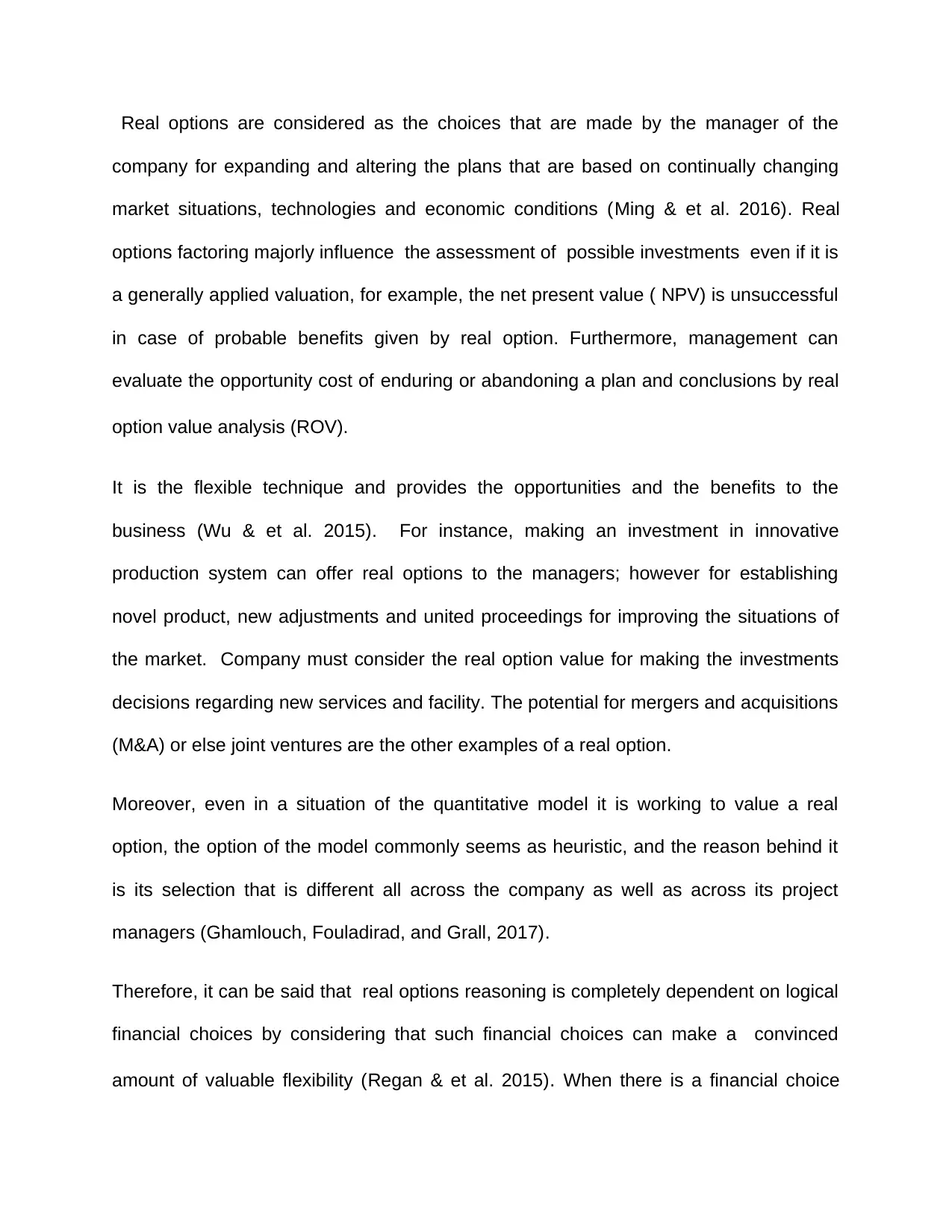
Real options are considered as the choices that are made by the manager of the
company for expanding and altering the plans that are based on continually changing
market situations, technologies and economic conditions (Ming & et al. 2016). Real
options factoring majorly influence the assessment of possible investments even if it is
a generally applied valuation, for example, the net present value ( NPV) is unsuccessful
in case of probable benefits given by real option. Furthermore, management can
evaluate the opportunity cost of enduring or abandoning a plan and conclusions by real
option value analysis (ROV).
It is the flexible technique and provides the opportunities and the benefits to the
business (Wu & et al. 2015). For instance, making an investment in innovative
production system can offer real options to the managers; however for establishing
novel product, new adjustments and united proceedings for improving the situations of
the market. Company must consider the real option value for making the investments
decisions regarding new services and facility. The potential for mergers and acquisitions
(M&A) or else joint ventures are the other examples of a real option.
Moreover, even in a situation of the quantitative model it is working to value a real
option, the option of the model commonly seems as heuristic, and the reason behind it
is its selection that is different all across the company as well as across its project
managers (Ghamlouch, Fouladirad, and Grall, 2017).
Therefore, it can be said that real options reasoning is completely dependent on logical
financial choices by considering that such financial choices can make a convinced
amount of valuable flexibility (Regan & et al. 2015). When there is a financial choice
company for expanding and altering the plans that are based on continually changing
market situations, technologies and economic conditions (Ming & et al. 2016). Real
options factoring majorly influence the assessment of possible investments even if it is
a generally applied valuation, for example, the net present value ( NPV) is unsuccessful
in case of probable benefits given by real option. Furthermore, management can
evaluate the opportunity cost of enduring or abandoning a plan and conclusions by real
option value analysis (ROV).
It is the flexible technique and provides the opportunities and the benefits to the
business (Wu & et al. 2015). For instance, making an investment in innovative
production system can offer real options to the managers; however for establishing
novel product, new adjustments and united proceedings for improving the situations of
the market. Company must consider the real option value for making the investments
decisions regarding new services and facility. The potential for mergers and acquisitions
(M&A) or else joint ventures are the other examples of a real option.
Moreover, even in a situation of the quantitative model it is working to value a real
option, the option of the model commonly seems as heuristic, and the reason behind it
is its selection that is different all across the company as well as across its project
managers (Ghamlouch, Fouladirad, and Grall, 2017).
Therefore, it can be said that real options reasoning is completely dependent on logical
financial choices by considering that such financial choices can make a convinced
amount of valuable flexibility (Regan & et al. 2015). When there is a financial choice
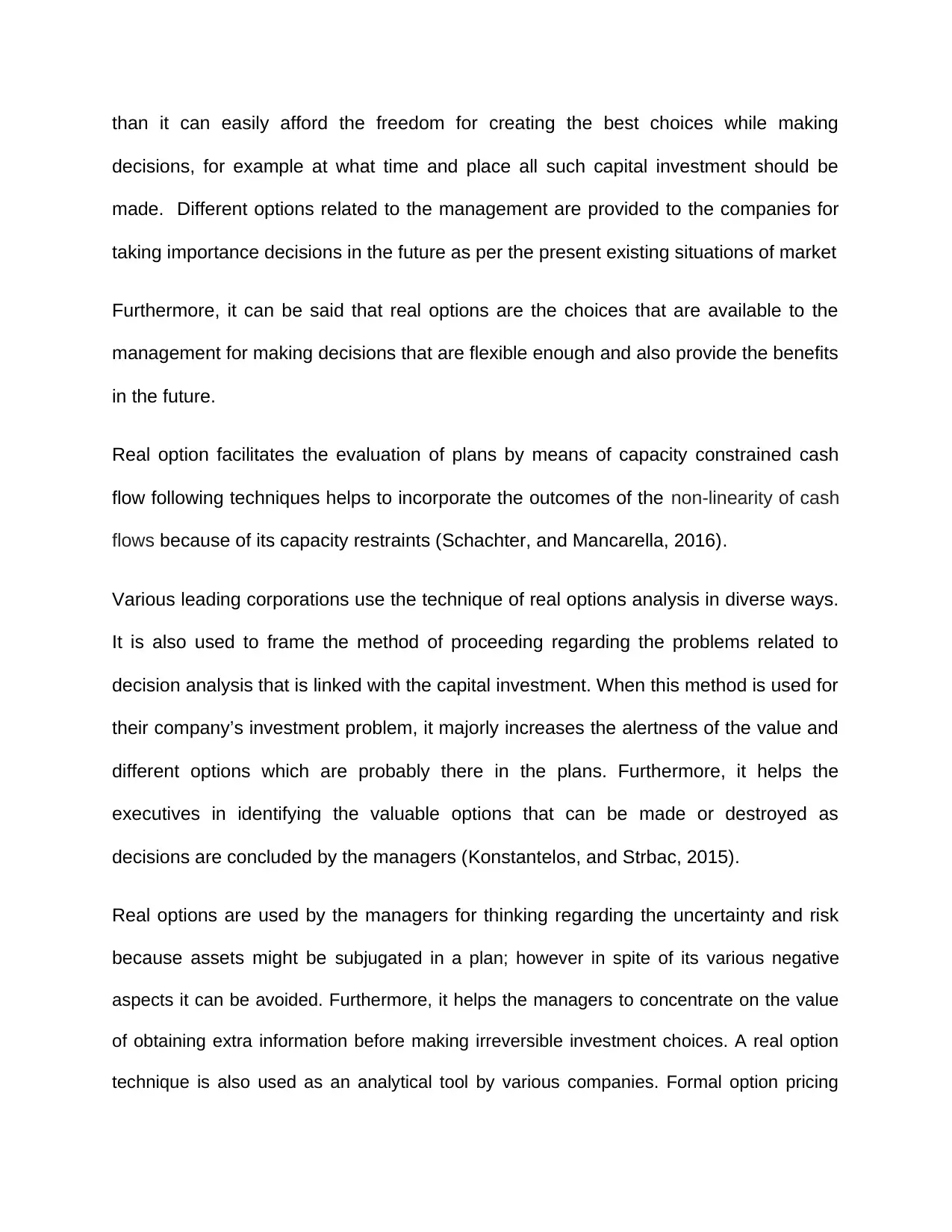
than it can easily afford the freedom for creating the best choices while making
decisions, for example at what time and place all such capital investment should be
made. Different options related to the management are provided to the companies for
taking importance decisions in the future as per the present existing situations of market
Furthermore, it can be said that real options are the choices that are available to the
management for making decisions that are flexible enough and also provide the benefits
in the future.
Real option facilitates the evaluation of plans by means of capacity constrained cash
flow following techniques helps to incorporate the outcomes of the non-linearity of cash
flows because of its capacity restraints (Schachter, and Mancarella, 2016).
Various leading corporations use the technique of real options analysis in diverse ways.
It is also used to frame the method of proceeding regarding the problems related to
decision analysis that is linked with the capital investment. When this method is used for
their company’s investment problem, it majorly increases the alertness of the value and
different options which are probably there in the plans. Furthermore, it helps the
executives in identifying the valuable options that can be made or destroyed as
decisions are concluded by the managers (Konstantelos, and Strbac, 2015).
Real options are used by the managers for thinking regarding the uncertainty and risk
because assets might be subjugated in a plan; however in spite of its various negative
aspects it can be avoided. Furthermore, it helps the managers to concentrate on the value
of obtaining extra information before making irreversible investment choices. A real option
technique is also used as an analytical tool by various companies. Formal option pricing
decisions, for example at what time and place all such capital investment should be
made. Different options related to the management are provided to the companies for
taking importance decisions in the future as per the present existing situations of market
Furthermore, it can be said that real options are the choices that are available to the
management for making decisions that are flexible enough and also provide the benefits
in the future.
Real option facilitates the evaluation of plans by means of capacity constrained cash
flow following techniques helps to incorporate the outcomes of the non-linearity of cash
flows because of its capacity restraints (Schachter, and Mancarella, 2016).
Various leading corporations use the technique of real options analysis in diverse ways.
It is also used to frame the method of proceeding regarding the problems related to
decision analysis that is linked with the capital investment. When this method is used for
their company’s investment problem, it majorly increases the alertness of the value and
different options which are probably there in the plans. Furthermore, it helps the
executives in identifying the valuable options that can be made or destroyed as
decisions are concluded by the managers (Konstantelos, and Strbac, 2015).
Real options are used by the managers for thinking regarding the uncertainty and risk
because assets might be subjugated in a plan; however in spite of its various negative
aspects it can be avoided. Furthermore, it helps the managers to concentrate on the value
of obtaining extra information before making irreversible investment choices. A real option
technique is also used as an analytical tool by various companies. Formal option pricing
⊘ This is a preview!⊘
Do you want full access?
Subscribe today to unlock all pages.

Trusted by 1+ million students worldwide
1 out of 19
Related Documents
Your All-in-One AI-Powered Toolkit for Academic Success.
+13062052269
info@desklib.com
Available 24*7 on WhatsApp / Email
![[object Object]](/_next/static/media/star-bottom.7253800d.svg)
Unlock your academic potential
Copyright © 2020–2026 A2Z Services. All Rights Reserved. Developed and managed by ZUCOL.





